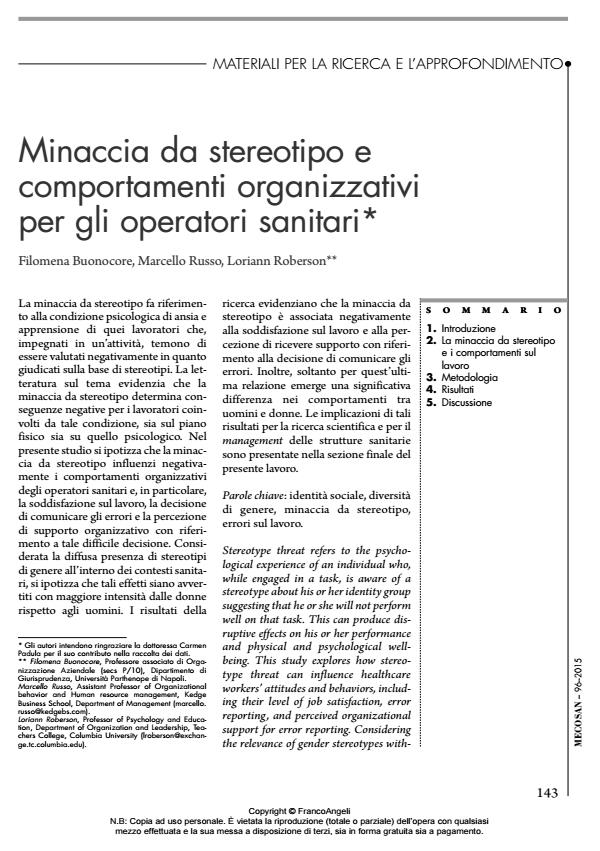Minaccia da stereotipo e comportamenti organizzativi per gli operatori sanitari
Titolo Rivista MECOSAN
Autori/Curatori Filomena Buonocore, Marcello Russo, Loriann Roberson
Anno di pubblicazione 2016 Fascicolo 2015/96
Lingua Italiano Numero pagine 15 P. 153-158 Dimensione file 166 KB
DOI 10.3280/MESA2015-096007
Il DOI è il codice a barre della proprietà intellettuale: per saperne di più
clicca qui
Qui sotto puoi vedere in anteprima la prima pagina di questo articolo.
Se questo articolo ti interessa, lo puoi acquistare (e scaricare in formato pdf) seguendo le facili indicazioni per acquistare il download credit. Acquista Download Credits per scaricare questo Articolo in formato PDF

FrancoAngeli è membro della Publishers International Linking Association, Inc (PILA)associazione indipendente e non profit per facilitare (attraverso i servizi tecnologici implementati da CrossRef.org) l’accesso degli studiosi ai contenuti digitali nelle pubblicazioni professionali e scientifiche
La minaccia da stereotipo fa riferimento alla condizione psicologica di ansia e apprensione di quei lavoratori che, impegnati in un’attività, temono di essere valutati negativamente in quanto giudicati sulla base di stereotipi. La letteratura sul tema evidenzia che la minaccia da stereotipo determina conseguenze negative per i lavoratori coinvolti da tale condizione, sia sul piano fisico sia su quello psicologico. Nel presente studio si ipotizza che la minaccia da stereotipo influenzi negativamente i comportamenti organizzativi degli operatori sanitari e, in particolare, la soddisfazione sul lavoro, la decisione di comunicare gli errori e la percezione di supporto organizzativo con riferimento a tale difficile decisione. Considerata la diffusa presenza di stereotipi di genere all’interno dei contesti sanitari, si ipotizza che tali effetti siano avvertiti con maggiore intensità dalle donne rispetto agli uomini. I risultati della ricerca evidenziano che la minaccia da stereotipo è associata negativamente alla soddisfazione sul lavoro e alla percezione di ricevere supporto con riferimento alla decisione di comunicare gli errori. Inoltre, soltanto per quest’ultima relazione emerge una significativa differenza nei comportamenti tra uomini e donne. Le implicazioni di tali risultati per la ricerca scientifica e per il management delle strutture sanitarie sono presentate nella sezione finale del presente lavoro.
Parole chiave:Identità sociale, diversità di genere, minaccia da stereotipo, errori sul lavoro.
- Leadership femminile in sanità: possibili soluzioni e strumenti. Un caso di studio Paola Paoloni, Francesca Dal Mas, Amelia Barcellini, in MECOSAN 120/2022 pp.83
DOI: 10.3280/MESA2021-120006
Filomena Buonocore, Marcello Russo, Loriann Roberson, Minaccia da stereotipo e comportamenti organizzativi per gli operatori sanitari in "MECOSAN" 96/2015, pp 153-158, DOI: 10.3280/MESA2015-096007